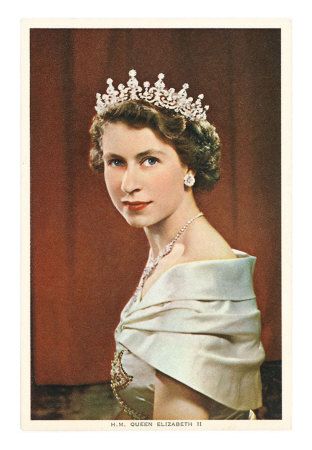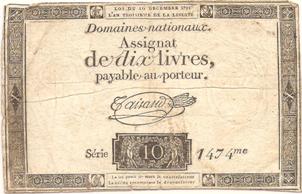A few days ago we heard the sad news that Dutch mountaineer Eric Arnold had died while climbing the Mount Everest. He was only 35 years old. The day before he had been finally successful (after 4 failed attempts in previous years) in reaching the summit. During the descent from the top it is believed he died from altitude sickness. Two other people have died from the same climbing group.
Mountains and the people who try to climb them have always sparked people's imagination and admiration. So it's no surprise we can find several of them on banknotes from different countries. The highest of them all, the Mount Everest (although that is up for debate), is on the banknotes of at least three two different countries: Nepal and China and New Zealand.
The last note from New Zealand is of course the Banknote of the Year 2015. It is also one of two notes I could find with an actual climber on it, in this case the famous Sir Edmund Hillary who was the first to climb to the summit of Mount Everest in 1953. Update: you know that feeling when you've always assumed something to be obvious just to find out it's not true? Well... I always assumed the mountain on the 5-dollar note from New Zealand to be Mount Everest since it has Sir Edmund Hillary on it but as Wez correctly pointed out in the comments it's Mount Cook, the highest mountain in New Zealand.
The other note I could find with mountaineers on it, is the 500-intis note from Peru.
One other mountaineer deserves to be included in this story and that is Sean Prockter from Jasper, Canada. He made the news last year when he was the first person to climb all 7 peaks shown on the Canadian 10-dollar banknote in one season.
Although banknote collecting is my biggest hobby, I do have several other interests keeping me off the streets. Fountain pens and fountain pen ink for instance. I have collected several fountain pens and use them all the time. I just love tinkering with the pens, diassembling them, cleaning them and filling the pens up with all kinds of beautiful new ink colors. For me there's some great satisfaction in finding a beautiful fountain pen, combining it with a gorgeous ink color and writing smoothly with it on a blank piece of paper.
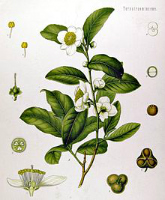 Another 'hobby' is tea. Or not so much a hobby perhaps but definitely something I enjoy very much. I visit a local tea shop regularly searching for new varieties and tastes. Again, I get a huge feeling of satisfaction when I manage to brew a delicious cup of tea from some tea variety I hadn't tried out before.
Another 'hobby' is tea. Or not so much a hobby perhaps but definitely something I enjoy very much. I visit a local tea shop regularly searching for new varieties and tastes. Again, I get a huge feeling of satisfaction when I manage to brew a delicious cup of tea from some tea variety I hadn't tried out before.
When having several hobbies it's always nice if these separate worlds collide. I was searching in vain for banknotes with fountain pens on them (if anybody knows any, please let me know) when I did stumble upon banknotes with tea motives on them. Several countries that produce tea have issued banknotes in the past with scenes of tea plantations on them or people picking tea. And of course there are tea pavillions where tea ceremonies are usually held.
Here's a little taste (no pun intended) of my search for 'tea banknotes' after the click.
Read More
Last night we could see something in the sky which is pretty rare in The Netherlands but occurs more often in countries like Norway: Aurora Borealis, or northern lights. This Norwegian banknote of 200 kroner (P48/50) features a portrait of Norwegian scientist Kristian Birkeland (1867-1917) who discovered what causes this spectacular phenomenon.
Birkeland organized several expeditions to Norway's high-latitude regions where he established a network of observatories under the auroral regions to collect magnetic field data. The results of the Norwegian Polar Expedition conducted from 1899 to 1900 contained the first determination of the global pattern of electric currents in the polar region from ground magnetic field measurements. The discovery of X-rays inspired Birkeland to develop vacuum chambers to study the influence of magnets on cathode rays. Birkeland noticed that an electron beam directed toward a magnetised terrella was guided toward the magnetic poles and produced rings of light around the poles and concluded that the aurora could be produced in a similar way. He developed a theory in which energetic electrons were ejected from sunspots on the solar surface, directed to the Earth, and guided to the Earth's polar regions by the geomagnetic field where they produced the visible aurora. This is essentially the theory of the aurora today.
The front of the note shows northern lights rising upwards to the North Star. Also visible are the Little Bear (Ursa Minor) and the Big Dipper constellations. Birkeland's Terrella is shown on the left. On the back of the note is a map of the North Polar region. Northern lights are visible along the coast of northern Norway at night; they are visible over Svalbard, a Norwegian archipelago in the Arctic Ocean, during the day. We also see a depiction of Birkeland's thoughts about the orientation of electric currents in connection with the northern lights. Currents near the auroral arcs flow parallel to the ground, while those that are higher up flow along the earth's magnetic field lines. These currents are called Birkeland Currents.
(This article was also published on the Space and Astronomy Banknotes blog)
Sources used: 1, 2
Last weekend was the bi-annual World Paper Money Fair Maastricht in the lovely town of Valkenburg aan den Geul in the deep, very deep south of the Netherlands. The trip is about 400 km back and forth for me. I've driven those distances before in the USA but 400 km in the Netherlands is quite different from 400 km in the USA.
I was at the fair for the first time last year but I didn't really enjoy myself then because of all the high prices dealers asked for their banknotes. This year I went with different expectations. I had a clear budget, a goal (new countries) and I was determined to just enjoy the expensive banknotes for their looks and concentrate on the cheaper notes for buying.
This proved to be a succes. The first stall I visited and the first beautiful note I looked at was a whopping €12,000 worth! That note was just a little above my budget so I decided to move on. A few hours later I had bought as many notes as my budget permitted and after a lunch in the beautiful neighborhood I drove back home. I will definitely come back in the spring of 2014!
This weekend I visited the World Paper Money Fair Maastricht in Valkenburg a/d Geul. In short: I liked it a lot and I've bought some great new banknotes. A more extensive review will follow tomorrow!
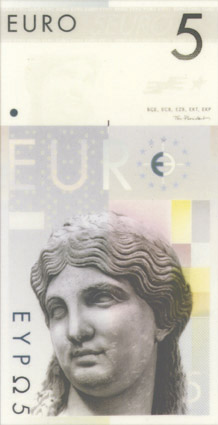 That question will be answered next week when on 10 January 2013 the ECB will unveil the design of the new 5 euro banknote. Don't expect to many changes though. As the ECB clearly states on the website for the new Europa series:
That question will be answered next week when on 10 January 2013 the ECB will unveil the design of the new 5 euro banknote. Don't expect to many changes though. As the ECB clearly states on the website for the new Europa series:
Like the first series, the new banknotes will feature the “ages and styles” design and show windows, doorways and bridges.
So in other words: the same (boring) design we have all come to love/hate (choose for yourself). The current banknotes are designed by Robert Kalina of the National Bank of Austria. For the second series the ECB has asked Reinhold Gerstetter to update the design. He is known for his work on the last series of German Marks (example of his 200 Mark, P47) and on the last series of Spanish Pesetas.
But what most people don't know, is that Reinhold Gerstetter has already designed euro banknotes years ago. The contest in which Robert Kalina was chosen as the winner to design the currect euro banknotes, also had several other contestants. One of them was Reinhold Gerstetter. He designed two different series for this competition. You can find the first series here and the second series here. A funny coincidence: the face of his 5 euro design (photo on the right) shows the image of Europa, which is also the leading theme for the second series of the euro banknotes.
Will the new banknotes look anything like his original design? Probably not, but we'll know for sure next week.
>> Link: All the original entries for the euro design competition in 1996
 I've compiled a list of a lot of security feautures which can be found on banknotes these days. These aren't all security features known today but as a first try, it's fairly complete. The list will be updated when possible.
I've compiled a list of a lot of security feautures which can be found on banknotes these days. These aren't all security features known today but as a first try, it's fairly complete. The list will be updated when possible.
You can find the list here or in the menu on the right under 'help with collecting'.
 While many people today believe that the U.S. $100 note is the highest denomination, in reality there are 5 notes with higher values: €500, $1000, $5000, $10.000 and $100.000. These are however no longer used. The higher values were once used when there was still a lot of mining for gold in the U.S. To avoid walking around with hundreds of banknotes, higher values were added. The $100.000 note was meant specifically for traffic between banks and was never issued to the public. There are 20.113 of these banknotes with the highest value.
While many people today believe that the U.S. $100 note is the highest denomination, in reality there are 5 notes with higher values: €500, $1000, $5000, $10.000 and $100.000. These are however no longer used. The higher values were once used when there was still a lot of mining for gold in the U.S. To avoid walking around with hundreds of banknotes, higher values were added. The $100.000 note was meant specifically for traffic between banks and was never issued to the public. There are 20.113 of these banknotes with the highest value.
These notes were printed until 1945 and from 1969 the values higher than $100 were no longer being used in daily traffic. The notes which still exist belong to collectors and museum but have still kept their value and you could still use them to pay for things in the United States in theory.
500 Dollar
More pictures after the break!
Read More
So BanknoteNews has a fun new challenge: identifying who Sister Sarah is on the Bahamas 1/2 dollar note (P42). When I was doing some research on my own collection I too ran into this problem. She is prominently featured on the banknote with her name next to her picture but I couldn't find any information on her.
But the readers of BanknoteNews have apparently found out who she is.
IDENTIFIED: According to Paul Walters, "Sister Sarah is indeed a real person. I am not sure if she is still living, I don't think she is. She was a prominant figure at the straw market in the 1970s, when the market was located along the dock--before it moved to its present day location on Bay street."
They also found an article mentioning her as a local straw weaver. Has the riddle finally been solved?
 I read an interesting topic on the members forum of the IBNS. Somebody has a special collecting theme: UNESCO sites on banknotes. UNESCO stands for United Nations Educational, Scientific and Cultural Organization.
I read an interesting topic on the members forum of the IBNS. Somebody has a special collecting theme: UNESCO sites on banknotes. UNESCO stands for United Nations Educational, Scientific and Cultural Organization.
What are these sites? To quote UNESCO: "The World Heritage List includes 962 properties forming part of the cultural and natural heritage which the World Heritage Committee considers as having outstanding universal value." Countries like to put sites on their banknotes which are the pride of a nation so it should come as no surprise that quite a few of the current 962 sites have ended up on banknotes thoughout the world.
Right now people on the IBNS forum are compiling a list of the sites, so it's 'work in progress'. The list is impressive so far and can be viewed after the click (pick numbers and the exact banknote will be added later by the collectors):
Read More
 Voor het eerst ben ik ook slachtoffer geworden van een mislukte postbezorging. Ik had drie Japanse biljetten aangeschaft via eBay en deze zijn vanuit de Verenigde Staten naar mijn adres gezonden. Helaas zijn ze daar nooit aangekomen. Het voordeel van de aanschaf via eBay en betaling met PayPal is dat je aankoop volledig verzekerd is. Dus na de verplichte wachtperiode van 40 dagen kreeg ik na een mailtje aan de verkoper mijn geld weer volledig teruggestort.
Voor het eerst ben ik ook slachtoffer geworden van een mislukte postbezorging. Ik had drie Japanse biljetten aangeschaft via eBay en deze zijn vanuit de Verenigde Staten naar mijn adres gezonden. Helaas zijn ze daar nooit aangekomen. Het voordeel van de aanschaf via eBay en betaling met PayPal is dat je aankoop volledig verzekerd is. Dus na de verplichte wachtperiode van 40 dagen kreeg ik na een mailtje aan de verkoper mijn geld weer volledig teruggestort.
Het was maar drie euro gelukkig maar vervelender vind ik dat Japan nog steeds ontbreekt in mijn collectie. En waar zouden de drie Japanse biljetten zijn gebleven? Ergens in de machine blijven hangen of wellicht bij een vrolijke postbode op zijn schoorsteenmantel? Het kost wat meer maar ik heb toch liever aangetekende post.
Lately I've been seeing a lot of so called 'Euro misprints' and 'Euro printing errors' on eBay. These banknotes have wrong cuts showing a portion of another banknote. You also see banknotes where the picture seems to have shifted to the side. High prices are being asked and paid for these notes. Great for collectors right?
Well no, because they're all fake.
The truth is there are hardly any real misprints of the Euro currently on the market. Let alone such obvious ones. Before a note is issued it has to face check after check after check, both mechanically and by a human inspector. A note which has half of two notes on it would never pass such a test. So what are these so called misprints? Are they fake banknotes? Yes. Sort of.
In reality these are 'misprints' which have been manufactured by the sellers themselves by cutting a large sheet of banknotes. In Germany you can buy Euro sheets of 5, 10 and 20 Euros as sort of a curiosity. Most people don't even know this but in the USA it's much more common to buy and sell or give so called 'uncut sheets' of dollars. In Europe this is only possible in the money museum at the Bundesbank in Frankfurt. The original sheets can be ordered here. The only downside: you have to collect them in person in Frankfurt.
The sheets of 5 euro are sold in sheets of 60 notes at a price of € 480. The sheets with notes of 10 euro are sold with 54 notes in one sheet at a price of € 860. The 20 euro is sold in a sheet of 45 notes at a price of € 1440. I presume the 20 euro sheet is a bit too expensive for the creative cutters because I haven't seen them appear on eBay yet. The three varieties look like this:
By making the cut right through a note instead of between two notes, you're able to make your own 'misprint'. Which can of course be a lot of fun but not when you try to scam other collectors by selling them for high prices as a real misprint. Luckily for us they are easily recognizable.
The 5 euros in such a sheet always have a serial number starting with X0659. The 10 euro notes always have a serial number starting with X1017. If you come accross a 'misprint' and you see one of these serial numbers, you know it's a fake. The Bundesbank only sells complete sheets so even the varieties with 2 or 4 notes in a sheet have been cut from a bigger sheet.
Below are some creative ways in which these scam artists try to make money at the expense of unknowing collectors. All these examples have been copied from advertisements on eBay:
My advice: don't buy these items because they're not worth the price which is being asked for them.
Zoals eerder aangekondigd zou ik nog een achtergrondstukje schrijven over het Canadese Duivelsbiljet dat ik onlangs op de kop wist te tikken.
In 1952 volgde Elizabeth Alexandra Mary Windsor haar vader koning George VI op als koningin en werd vanaf dat moment Elizabeth II. Als koningin van het Verenigd Koninkrijk was ze automatisch ook Head of State van vele landen van de Commonwealth. Als officieel staatshoofd heeft Elizabeth II de bankbiljetten van 33 landen en gebieden gesierd. Eén daarvan is Canada.
Zoals dat gaat na een troonswisseling werd in 1952 opdracht gegeven om een nieuw Canadees bankbiljet te ontwerpen met het gezicht van het nieuwe staatshoofd erop. Gekozen werd om het ontwerp te baseren op een foto van de Canadese fotograaf Yousuf Karsh. Na selectie van de foto wordt een ontwerp gemaakt door graveur George Gunderson dat ter goedkeuring aan de koningin zelf wordt voorgelegd en als die er een klap op geeft, wordt vervolgens de rest van de procedure gevolgd. Het uiteindelijke resultaat leverde in 1954 een nieuwe serie bankbiljetten op.
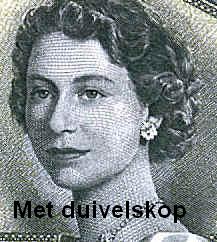 So far so good en niets bijzonders. In datzelfde jaar kwamen er echter bijzondere klachten binnen bij de Bank of Canada. Er werd beweerd dat in het ontwerp van het kapsel van Elizabeth II een grijnzende duivel verstopt was! En inderdaad: zonder al teveel fantasie te gebruiken kon je in de krullen van de koningin achter haar oor een gezicht herkennen. Was het toeval of opzet?
So far so good en niets bijzonders. In datzelfde jaar kwamen er echter bijzondere klachten binnen bij de Bank of Canada. Er werd beweerd dat in het ontwerp van het kapsel van Elizabeth II een grijnzende duivel verstopt was! En inderdaad: zonder al teveel fantasie te gebruiken kon je in de krullen van de koningin achter haar oor een gezicht herkennen. Was het toeval of opzet?
De ontwerper Gunderson claimde onschuldig te zijn aan de mogelijke majesteitsschennis: hij had alleen de foto overgezet naar een tekening. Er werd gekeken of er misschien een grapjas bij de bank zelf aan het werk was geweest die het ontwerp veranderd had. Of was het wellicht het werk van Frans-Canadese nationalisten die de niet gewenste Engelse koningin zo belachelijk wilden maken? De wildste theorieën deden de ronde.
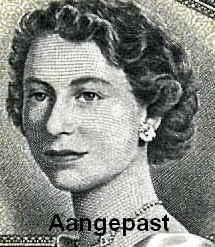 Er kon uiteindelijk geen schuldige worden aangewezen maar de Bank of Canada had al maatregelen genomen. De volledige serie van 1954 werd gecancelled en uit het betalingsverkeer genomen. Een nieuw ontwerp met een aangepast kapsel werd zo snel mogelijk uitgebracht. De oude bankbiljetten werden echter zeer geliefd en gezocht onder verzamelaars die de 'duivelsbiljetten' maar wat graag aan hun collectie wilden toevoegen.
Er kon uiteindelijk geen schuldige worden aangewezen maar de Bank of Canada had al maatregelen genomen. De volledige serie van 1954 werd gecancelled en uit het betalingsverkeer genomen. Een nieuw ontwerp met een aangepast kapsel werd zo snel mogelijk uitgebracht. De oude bankbiljetten werden echter zeer geliefd en gezocht onder verzamelaars die de 'duivelsbiljetten' maar wat graag aan hun collectie wilden toevoegen.
Hoe kon het nu uiteindelijk zo fout gaan met het ontwerp? De oorspronkelijke foto was er één uit een fotosessie genomen op het moment dat Elizabeth nog prinses was. Er wordt gezegd dat de Bank of Canada deze foto koos omdat dit er één was zonder tiara om op die manier de Frans-Canadese nationalisten uit Quebec tegemoet te komen. Hoe dan ook zijn er van die fotosessie meer foto's bewaard gebleven, zoals onderstaande foto.
Met wat (meer) fantasie is daar ook een bepaalde vorm in de krullen te ontdekken. De duivelskop lijkt dan ook, alle complottheoriën ten spijt, een bizar toeval maar wel eentje die bij het oorspronkelijke ontwerp wellicht eerder opgemerkt had kunnen en moeten worden.
Meer informatie over de beeltenissen van Elizabeth II op diverse bankbiljetten door de jaren heen is te vinden in dit mooie overzicht van PJ Symes.
Ik heb deze week een oud bankbiljet aan mijn verzameling toegevoegd, namelijk een biljet van 10 Livres dat uitgegeven is tijdens de Franse Revolutie. Dit is een zogenaamd Assignaat.
Op Wikipedia is de geschiedenis van deze interessante biljetten mooi samengevat:
De rellen aan het begin van de Franse Revolutie hadden de Fermiers of belastingsinners verdreven. Het chaotische revolutionaire regime was niet in staat tijdig een nieuwe belastingsadministratie op poten te zetten om de lopende uitgaven en de rente op de staatsschuld te betalen. Het water stond de nieuwe regering werkelijk aan de lippen. Om een bankroet te vermijden besloot de "Assemblée Nationale" op 2 november 1789 om alle kerkelijke bezittingen te confisqueren. De staat zou voortaan een salaris betalen aan de priesters, voor zover die tenminste een eed van trouw aan de Republiek hadden gezworen.
Een probleem hierbij was echter dat je al dat bezit (misschien een vijfde van het grondbezit van Frankrijk) niet tegelijk op de markt kon werpen, zonder dat de opbrengst tot een fractie van de werkelijke waarde zou dalen. Daarom werd besloten de verkoop over een aantal jaren te spreiden en in de tussentijd waardepapieren uit te geven met de kerkelijke bezittingen als onderpand. Die papieren zouden worden gebruikt om rente en aflossing van de staatsschuld mee te betalen. Naarmate de verkoop van de kerkbezittingen vorderde zou de staat de assignaten weer terugkopen van de houders. De assignaten werden uitgegeven in biljetten van 1000 francs (dat was destijds 1 of 2 jaarsalarissen van een arbeider).
Omdat het vertrouwen in de assignaten niet erg groot was en de staat in grote geldproblemen verkeerde, werd op 17 april 1790 besloten dat de assignaten ook als wettig betaalmiddel zouden gelden. Economisch geschoolde personen hadden hier een hard hoofd in en Jacques Necker, de minister van financiën, was hier zo sterk op tegen, dat hij zijn ontslag nam. De revolutionaire regering gaat bovendien veel meer assignaten in omloop brengen dan in overeenstemming is met de waarde van de geconfisqueerde kerkbezittingen. Het zou niemand hoeven te verbazen dat in die omstandigheden de waarde van de assignaten snel verminderde. Tussen 1790 en 1793 verloor de assignaat 60 % van zijn waarde.
Tijdens het Schrikbewind van Robespierre werd geprobeerd de waarde van de assignaat op peil tehouden door de doodstraf te stellen op het niet-aannemen van assignaten. Dit was een paardenmiddel dat op de lange termijn natuurlijk niet effectief zou blijken.
In 1796 was er voor 45 miljard frank (10 maal de waarde van de kerkbezittingen) aan assignaten in omloop. De assignaten-inflatie werd nog aangewakkerd doordat Engeland, dat met de Franse Republiek in oorlog verkeerde, welbewust vervalste assignaten in omloop bracht.
Op 19 februari 1796 werden de assignaten uit de circulatie genomen, maar wel tegen een voor de houders ervan ongunstige koers. Voor 30 frank aan assignaten wordt 1 frank in edelmetaal uitgekeerd.
Het avontuur van de assignaten heeft het revolutionaire regime in Frankrijk van de financiële ondergang gered. De kopers van kerkbezittingen en ondernemers die lucratieve overheidsleveringen hadden verricht en erin geslaagd waren de door hen ontvangen assignaten door te verkopen voordat ze te veel aan waarde verloren, hebben goede zaken gedaan, maar veel mensen hebben aan deze affaire veel geld verloren.
Bron: http://nl.wikipedia.org/wiki/Assignaat
|
Toon berichten 1-15 van 16 |
Volgende Pagina »
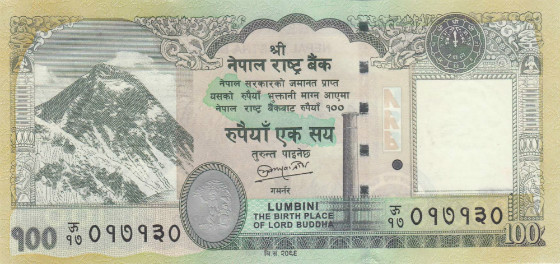
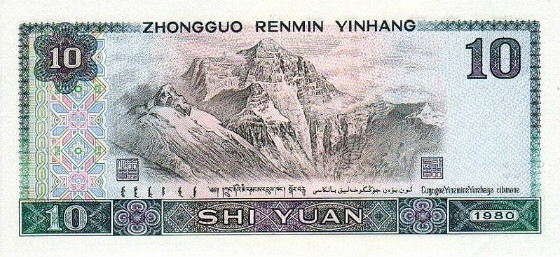
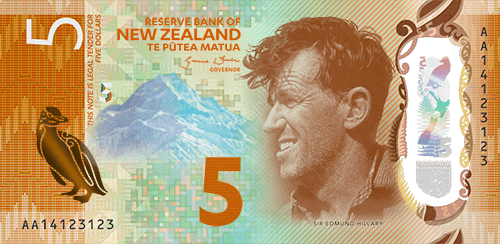
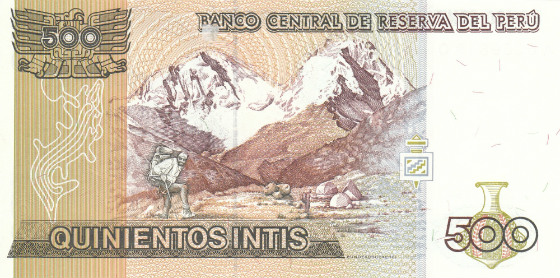


 Another 'hobby' is tea. Or not so much a hobby perhaps but definitely something I enjoy very much. I visit a local tea shop regularly searching for new varieties and tastes. Again, I get a huge feeling of satisfaction when I manage to brew a delicious cup of tea from some tea variety I hadn't tried out before.
Another 'hobby' is tea. Or not so much a hobby perhaps but definitely something I enjoy very much. I visit a local tea shop regularly searching for new varieties and tastes. Again, I get a huge feeling of satisfaction when I manage to brew a delicious cup of tea from some tea variety I hadn't tried out before.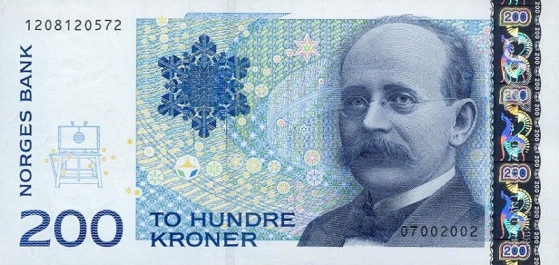
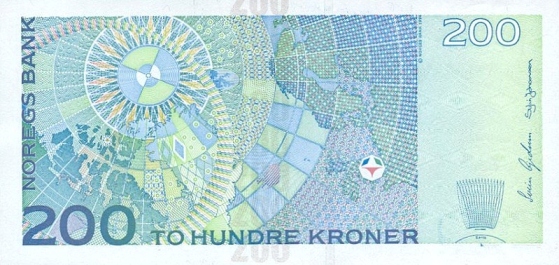
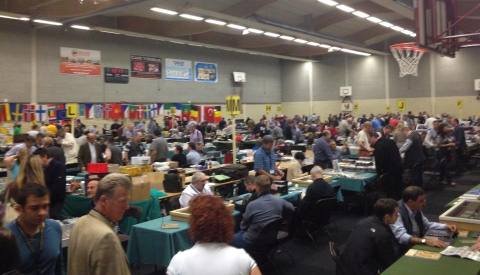
 That question will be answered next week when on 10 January 2013 the
That question will be answered next week when on 10 January 2013 the  I've compiled a list of a lot of security feautures which can be found on banknotes these days. These aren't all security features known today but as a first try, it's fairly complete. The list will be updated when possible.
I've compiled a list of a lot of security feautures which can be found on banknotes these days. These aren't all security features known today but as a first try, it's fairly complete. The list will be updated when possible. While many people today believe that the U.S. $100 note is the highest denomination, in reality there are 5 notes with higher values: €500, $1000, $5000, $10.000 and $100.000. These are however no longer used. The higher values were once used when there was still a lot of mining for gold in the U.S. To avoid walking around with hundreds of banknotes, higher values were added. The $100.000 note was meant specifically for traffic between banks and was never issued to the public. There are 20.113 of these banknotes with the highest value.
While many people today believe that the U.S. $100 note is the highest denomination, in reality there are 5 notes with higher values: €500, $1000, $5000, $10.000 and $100.000. These are however no longer used. The higher values were once used when there was still a lot of mining for gold in the U.S. To avoid walking around with hundreds of banknotes, higher values were added. The $100.000 note was meant specifically for traffic between banks and was never issued to the public. There are 20.113 of these banknotes with the highest value.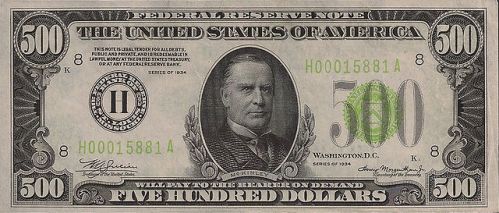
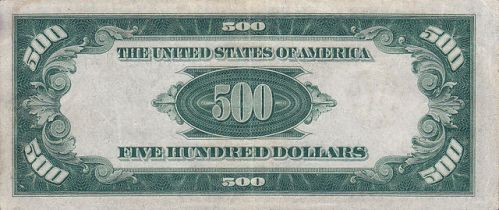
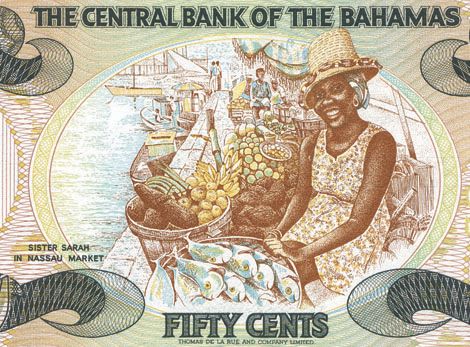
 I read an interesting topic on the members forum of the
I read an interesting topic on the members forum of the  Voor het eerst ben ik ook slachtoffer geworden van een mislukte postbezorging. Ik had drie Japanse biljetten aangeschaft via
Voor het eerst ben ik ook slachtoffer geworden van een mislukte postbezorging. Ik had drie Japanse biljetten aangeschaft via 









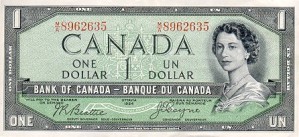
 So far so good en niets bijzonders. In datzelfde jaar kwamen er echter bijzondere klachten binnen bij de Bank of Canada. Er werd beweerd dat in het ontwerp van het kapsel van Elizabeth II een grijnzende duivel verstopt was! En inderdaad: zonder al teveel fantasie te gebruiken kon je in de krullen van de koningin achter haar oor een gezicht herkennen. Was het toeval of opzet?
So far so good en niets bijzonders. In datzelfde jaar kwamen er echter bijzondere klachten binnen bij de Bank of Canada. Er werd beweerd dat in het ontwerp van het kapsel van Elizabeth II een grijnzende duivel verstopt was! En inderdaad: zonder al teveel fantasie te gebruiken kon je in de krullen van de koningin achter haar oor een gezicht herkennen. Was het toeval of opzet? Er kon uiteindelijk geen schuldige worden aangewezen maar de
Er kon uiteindelijk geen schuldige worden aangewezen maar de 